
The acrylic medium for artists has now passed its 60th year since the first artists experimented and created with Bocour’s Magna®. I have been imagining and conjecturing with others for some time now what these materials might look like one hundred, five hundred or a thousand years from now. A significant body of evidence is being accumulated by colleagues in the field of conservation science and by our own research to begin to predict what these changes might be over time. Through processes of both accelerated exposures and real life exposures, we can develop a picture of these changes of the various acrylic surfaces, mediums and colors.
Although at GOLDEN, our philosophy and personal metaphor around working in the acrylic media has been to achieve a material with the clarity of glass and the resistance of stone. Realistically, not even these materials are left unscathed by the passing of time. Some may harden, soften, some stretch and ooze and others crack, some flake and others dust away; some colors may fade to white and others darken to brown. Some develop encrustations, ruptures, pits, stains, wrinkles, and organic growth. Change can take multiple forms and in conflicting directions in the same material.
Many of these changes we describe as the ‘patina’ of the object. These signs of age are due to changes shaped by wear, exposure to the elements and internal changes of the materials themselves. Some which are earned over a work’s historic record, and some that are created to give an object some instant age, character and/or unique aesthetic appearance. Fans of PBS’s ‘Antiques Roadshow’, have been thoroughly warned not to touch the original finish no matter how deteriorated or blemished rather than turn a priceless treasure into scrap.
Patina does not refer to all changes in an art object. Most objects conservators, historians and artists worldwide use the term patina much more broadly to define a very wide range of changes in many objects and works of art. But clearly its definition is limited to the very top visual surface of the object or painting. It does not refer to other changes that are more internal to the work of art. Typically we are just talking about no more than a couple of millimeters of the surface. IT IS the surface we see.
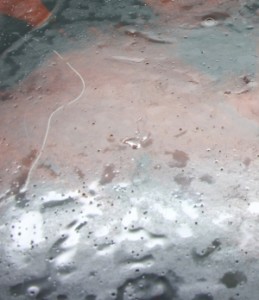
We have created within art, design and fashion entire industries in the production of instant age. Creating patinas is a serious business. Artisans have been distressing and beating up their furniture, even adding worm tracks to pieces. An entire field of metallurgy has been created to investigate how to create unique surfaces on metal. Artists have been adding materials to paint to cause cracking or flaking as well as tinting varnishes or mediums to give a “gold tone” to the surface. Even our clothes have been bleached out, made threadbare and torn, to give a greater sense of character to our style. Just this past year, several politicians have been charged with dying their hair gray to give them some greater gravitas.We tend to use the term “patina” to describe any wear or change in a material that gives it a sense of age… and the older it looks, the greater significance or importance we infer upon the work. This badge of age has been assigned by many authorities to materials including all the metals, marble, stone, glass, fresco, wood, leather, tapestry and paintings. By our very association of the word patina to an art or historical object, the object is inflected with an aura giving it greater substance, seriousness and interest. This aged visual appearance influences our understanding and appreciation of the object well beyond any actual color, pattern or surface change.
In the world of paintings and object conservation there has been much debate over assessing how much cleaning and removal of corrosion product is appropriate. Does the removal of the surface destroy a sense of the history of the object? Is one actually cleaning off its marks of distinction or a unique symmetry of balanced changes developed over time? At what point is a work of art so obscured by the accumulation of dust, grime, soot or internal discoloration or distortion of the surface, that it no longer represents the artist’s intentions? Even that ethic of restoring the artist’s original intentions has been and continues to be a hotly contested issue in conservation1, 2. Finally, at what point do these changes compromise the work aesthetically and it simply becomes an historical artifact of an artist’s work?
In the book, “The Future of Nostalgia”, Svetlana Boym, discusses the very controversial cleaning of Michelangelo’s Sistine Chapel3. Sharing the arguments of bringing this work back to its more vivid original colors, taking off years of grime, candle soot, and areas retouched by past restorers “attempting to extinguish the myth of the dark romantic genius in agony and ecstasy”… She asks this final question of us. “What is more authentic; the original image of Michelangelo preserved (as it was) through time, or a historical image that aged through centuries? What if Michelangelo rejected the temptation of eternal youth and reveled in the wrinkles of time?”
It is not simply because of the enlightened discoveries of modern conservation that we know that paints will change over time. It is clear that artists throughout the history of painting knew of the changes associated with their materials. They understood that their linseed oil would yellow with time and become more transparent. They understood that their resins would become even more amber and certainly understood that the oils would embrittle and potentially develop cracks in the work. When Sir Joshua Reynolds (1723-1792) was confronted with his own poor painting construction, he is said to have shared, “All good pictures crack”4. Artists also struggled with the permanency or lack thereof of the various colorants used and often concocted within their own studio or by their favorite alchemist or pharmacist. Eventually that task would be accomplished by the new breed of colormen of the late 17th and 18th centuries.
Our view of the history of art is through a lens of a continually shifting surface. We only have examples of works of art that have to some lesser or greater degree, changed over time. We have accepted, and in many cases embraced those changes in traditional materials. Reframing this concept; we are only concerned when an old painting doesn’t match our expectation of how an old painting should look.
How Will My Acrylics Age?
The question we are left to examine is: What is our expectation of our modern painting materials? Do we assume that they will have no change over time? That our acrylic paintings will become a frozen representation of our contemporary legacy?
What I hope to examine within the remainder of this piece is the evidence of change, as well as constancy of these materials. To investigate the potential future with the typical use of these materials as well as the potential for change with the expanding range of experimental techniques that these new materials have allowed. By understanding these changes, artists will be able to anticipate the visual movement of these materials as they age, and to work with these changes to be able to assure that the work viewed during the passage of time will be able to both retain that original intent imparted to the work when it was created as well as the history of the piece. It will also present some opportunities for artists to consider the mitigation or at least the slowing down of some of these expected changes.
No matter how durable and lightfast these materials may be, they will change. There are so many environmental, chemical and physical initiators of change that it is truly remarkable when we are able to observe any object of art or antiquity that exhibits only minor changes to its visible surface. These forces include light exposure (especially from ultraviolet sources), extremes of temperature and humidity, internal chemical cross linking or crystallization of materials, incompatible materials within the same work, man-made and environmental disasters, molds, mildews, insects and rodents, mechanical changes such as creep or migration, storing, crating and shipping work, cleaning artwork and the various solvents and chemicals they might be exposed to as well as the effects of pollution, to name just a few.
Given the durability, the flexibility, the general lightfastness of the acrylic specifically in comparison to other media, one would expect little change in the color or surface of the paint film. Yet these acrylic paint surfaces will change, and in ways different from other traditional media.
Due to the relatively recent invention of the acrylic as an artist’s medium, we have only a few examples of naturally aged films where we know exactly the constituents and exposure of the materials. Few studies have yet to be conducted in our museums surveying comparatively works produced in acrylic versus other media. In Stringari and Pratt’s research examining the acrylic media, they only briefly mention the acrylic paintings in the collection at MOMA “…overall, they are in quite good condition, unless they have been mishandled or subjected to extreme environments”5. For most of our and others’ testing, we have to depend upon accelerated aging of samples. Samples are typically exposed to conditions that either raise temperature or increase the intensity of the light, especially the UV radiation over some period of time to try to induce the change that might be anticipated with natural aging. Although this is admittedly less than perfect for a firm understanding of the changes we can expect, it is the best we have.
Acrylic’s Extraordinary Flexibility


As part of our collaborative research project with Buffalo State College in 1992, samples of acrylic gel mediums were applied to glass and then exposed to natural aging in north and west facing windows. We can see the degree of color change and opacifying relative to the thickness of application.The changes that will be most typical of acrylics early on as they age will not be a surprise to any artist who has worked with the medium. The acrylics provide extraordinary flexibility and resistance to cracking (other than in near freezing conditions). Eric Hagen examining 27-year-old samples of acrylic films produced by Marion Mecklenberg, was able to demonstrate that these films will continue to have the flexibility similar to relatively fresh, one-year-old films6. This advantage of flexibility also has its downside: the surface is more vulnerable to marring, dirt pick up and sticking to other surfaces.
Manufacturers of the acrylic resins define their thin films as quite clear, almost colorless. Working in collaboration with the technical team at Rohm & Haas® (now Dow®), we have been able to share how these materials are often used by artists and the need for cleaner and clearer raw acrylic as a starting point. In 2001 we began a process to construct our own acrylic polymer in an effort to gain a greater understanding of how to mitigate our concerns with the dispersion polymers currently available7.Most early acrylics made in the U.S. throughout the mid 1950’s through the mid 1990’s contained a common resin combining ethyl acrylate and methylmethacrylate.
Acrylic, a Porous Binder


molecular structure and are able to penetrate the acrylic film. The disadvantage is that one needs to be careful of the environment of a nonvarnished acrylic painting. Pollutants such as soot, smoke and general grime can penetrate with vapor into the acrylic film. The porous acrylic film is also subject to damage from well intentioned cleaning efforts. Oily deposits from handling acrylic paintings, especially those paintings with a very matte surface, are very difficult to remove and tend to also darken with time.The less apparent concern with the acrylic medium is its extreme porosity. The smooth glossy surfaces give the impression of an impermeable film. Some have claimed that the acrylic is a ‘closed system’. This would not be accurate. The acrylics are extremely porous, a condition that is exacerbated by the addition of pigments and the additives required to make a stable paint. The advantage of this porosity is that it can improve the adhesion of subsequent layers as well as oil paints that tend to have an even smaller
Changes Caused by Additives

These additives include the defoamers (typically mineral oils), wetting agents (ionic salts), surfactants (bridge chemicals between the water and nonwater phase of the dispersion), thickeners (acrylic acids, cellulose thickeners, urethanes) and preservatives. The hundreds of variations of these materials cause a range of changes in the final product, with potential for yellowing, greening, fogging, opacifying and leaching.To manufacture acrylic artist paint requires a significant number of formulating additives. Many of these additives, which are required to make a stable and workable paint, are volatile and evaporate, leaving the dried acrylic film. The additives that remain in the film are subject to the same forces of change that attack the acrylic polymer themselves. Few of these additives have the same physical and chemical resistance that the acrylic itself has. Many of these additives are responsible for the changes in the film as it ages. It is the responsibility of the manufacturing process to keep these required additives to a minimum and to evaluate each additive for its potential contribution to any changes in the dried acrylic.
Despite all these conditions and the complexity of formulation that can lead to change in the acrylic medium, this material still remains the most stable system for artist use. In research by Paul Whitmore in 1995 he was able to show that the acrylic polymer showed remarkable photochemical stability specifically when exposed to doses of near ultraviolet light that would take 5,000 years in a controlled museum environment to accumulate8. The research also showed that under conditions more equivalent to outdoor exposure, the acrylic polymer aged much more rapidly. This is particularly relevant to outdoor murals.

On right, one-eighth inch acrylic film.
In research conducted by our Lab, acrylic films of similar wet weight were poured, and allowed to thoroughly dry. They were then subjected to heat aging at 140° F for 400 hours. We can see the degree of color change in the heated gel samples compared to the controls.
In evaluations by Tom Learner while at the Tate, he was able to demonstrate the color changes in various white formulations both within acrylic, oil and alkyds9. We can see in the graph below that all of the acrylic samples evaluated exhibited the smallest degree of change in thermally aged samples up to 600 hours. The higher on the vertical scale, the greater the degree of yellowing of the sample. Again, remember that using heat to accelerate what will occur in real time is only a potential indicator of change, not the degree, severity or time scale can be implied.To be able to understand the changes in these thick acrylic films in context, it is necessary to share some control data of other work looking at acrylic and other traditional artist media. In thin films the acrylics show very little color. Compared to traditional materials the acrylics are almost transparent.

Evaluating Change in Gel Mediums
Specifically for evaluating purposes of the acrylic we are examining films above 1/8 inch thick. These thick films exacerbate the visual changes that would otherwise be too subtle to be visible, especially in reproductions. As these materials are being made more and more transparent, artists are working in thicker and thicker fashion as if working in thick watercolor or a cold glass. It is important that artists experimenting with these materials consider and are able to anticipate the potential for changes.
Although an imperfect method for making determinations of change that might take hundreds of years to occur, we have attempted to use accelerated UV exposure to demonstrate changes in the acrylic gel mediums. The most common change is a yellow to amber cast of the gel with some degree of increase in opacity in some of the examples. The thicker the gels, the greater tendency to also show bubbles trapped in the films. These same results are evident with accelerated aging using UV fluorescent equipment or Xenon Arc full light spectrum sources. Studies completed by Whitmore, Colaluca and Morris suggest that acrylics are subject to some of the same effects of oils stored in the dark.10 They demonstrated that after UV exposure they were able to reduce yellowing on their aged sample. They were less successful on reducing yellowing caused by the interaction of the acrylic and the support.
The most dramatic changes in surface color and translucency occur as the gels are made more matte in their appearance. This is typical as additional solids are added to the gels to reduce their overall gloss. As these films age, they both gain color and reduced clarity.

Support Induced Discoloration
One of the most significant culprits to the color change occurs when thick applications of acrylic gels are applied to cotton or linen canvas, Masonite® board, or other similar surfaces. We coined this potentially severe yellowing in our research paper in 1992, “Support Induced Discoloration”11. The waterborne acrylic, which contains significant surfactants or soaps is capable of drawing into it any of the water miscible components in the substrate, even through gesso layers, leaving the acrylic dramatically yellowed and darkened. This photo shows the effect of simply washing the canvas before applying the gesso and the gel medium. It is also possible to reduce this effect by using a primer such as our Polymer Medium to somewhat seal the canvas surface before priming12. Support Induced Discoloration is not apparent when working in a thinner fashion on even the dirtiest of substrates, as the thin acrylic dries too quickly to draw in too much of the components of the substrate.
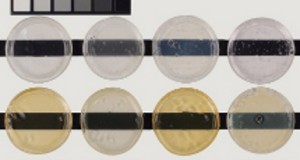

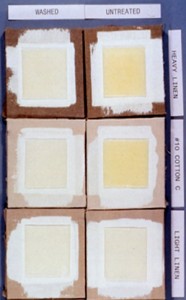
Acrylics are sensitive to most solvents, consequently, well intentioned attempts to clean an acrylic painting can cause problems. It is possible with the mildest of solvents and the lightest of intentions to abrade, dissolve, and scratch the acrylic film. The only solvents that can appropriately be used, creating the least damage to an acrylic film are mineral spirits and water. Unfortunately, mineral spirits does not work well as a cleaning agent, so one is left with the potential use of water on the work. If one was to read any of the popular conservation publications, it would suggest that because water will swell, it should not be used for cleaning an acrylic paint film. It has only been of very recent work, within the last few years, that there is some suggestion that application of water may work successfully to clean acrylic paintings. On our website in Just Paint Issue 5, we outlined the various dry cleaning methods to clean your paintings. We continue to advocate quite strongly that dried methods should be completed first and in some fragile work, only dried methods are appropriate.Sensitivity to Solvents.
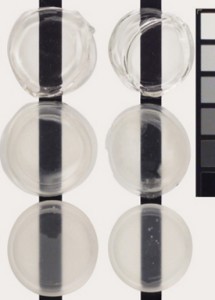
We have found in our research that cleaning with a damp non-linting cloth can work quite successfully without creating significant damage to artwork.13Although early in the research, it has been noted by several conservation scientists, that cleaning with water may even be quite advantageous.14 This is certainly something we can only recommend for the artist to try to attempt on their own work as they know the work and its construction most intimately. It would be naive of us to think that artists do not clean their own work. It is our responsibility to provide those resources to artists so that they may be successful and avoid solutions that clearly won’t work. Once the work leaves your studio, your clients should seek a paintings conservator that works with modern paintings. Many talented conservators are listed on the American Institute for Conservation (AIC) website, www.conservation-us.org.
The advantage of cleaning the acrylic film with water is that it is a wonderful cleaning solvent. It has also been found that just a damp cloth can be quite successful in removing some of the excess additives in the paint that exudes to the surface. The most common constituent of this surface accumulation of additive is ‘surfactant’. This surfactant is required as part of making the actual acrylic polymer dispersion. Surfactants are also used to make sure the pigment particles are well dispersed within the acrylic matrix. On drying they no longer serve a purpose and on the surface they can produce a blemish that can reduce the gloss and evenness of the painting. Simply wiping with water can remove this filmy material and improve the painting’s clarity. It can also aid in subsequent adhesion of varnishes to the final decorative surface of the painting.
Our MSA Acrylic (soluble in mineral spirits), which is the basis of our most important acrylic varnish, continues to be the most consistently clear of any acrylic binder. It is understandable that making these systems compatible with water increases the degree of change in these other acrylic systems.

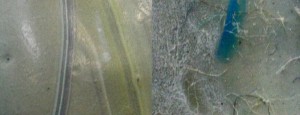
Although it is not possible within the scope of this article to review the advantages of varnishing your acrylic painting, (see Just Paint Issue 2 on our Web site) our system of isolation coat and final varnish will dramatically aid in preserving the original intent of the work while potentially adding a barrier coat and sacrificial coat for subsequent conservation to preserve your painting.
SUMMARY
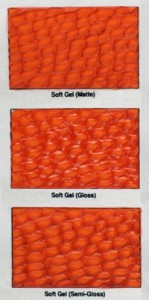
90% gel and 10% color, showing little
change when mixed with various gels.
We can surmise that the more matte, and thickly applied gel coats will age to a more opaque and more amber to brown appearance. We can also expect the thick gloss gels to also have some yellow component as well as a slight loss of clarity. We might also expect that matte acrylic paintings will have absorbed more pollution discoloration that will be difficult to remove. But for paintings constructed with more color than gel or other mediums, that the colors will remain quite crisp as long as a regular maintenance of dust removal or varnish application is considered.It is clear from our research and the work of many others, that the acrylics, as flexible, as lightfast and as clear as they may be, are still not perfect. They will exhibit change over time and this change, not so apparent yet to many artists, will become apparent over time. So what might this acrylic patina be called? “Gold tone” is already used by oil paint. It is unlikely that the acrylics will ever reach the level of yellowing of drying oils.
The acrylic medium remains the most permanent of artist painting media to date. The acrylics have so far shown to retain their exceptional flexibility and continued resistance to UV light. The acrylic colors have maintained their brillance over these last 60 years and should continue to do so.
The exciting part of this story is that it has not yet been completely written. As these materials continue to evolve, new approaches and new discoveries may mitigate even further the anticipated changes in the acrylics. Maybe someday these coatings will fulfill the potential to be the most permanent of materials in the service of art.
FOOTNOTES
1 Gerry Hedley, “Measured Opinions, Collected Papers on the Conservation of Paintings”, Edited by Caroline Villers, United Kingdom Institute for Conservation 1993, pp.152-167
2 Paul Philippot, “The Idea of Patina and the Cleaning of Paintings, (1966)”, (Garrett White, translator) Issues in the Conservation of Paintings, Reading in Conservation, David Bomford & Mark Leonard (ed.), Getty Conservation Institute, 2005, pp.391-395
3 Svetlana Boym, “The Future of Nostalgia”, Basic Books, 2001 p46.
4 M. Kierby Talley, Jr., “All Good Pictures Crack: Sir Joshua Reynolds’ Practice and Studio”, ‘Reynolds’, Edited by Nicholas Penny, Royal Academy of Arts, London, 1986, pp.55-70
5 Carol Stringari and Ellen Pratt, “The Identification and Characterization of Acrylic Emulsion Paint Media”, in David Grattan (ed.) Saving the Twentieth Century: The Conservation of Modern Materials, Canadian Conservation Institute, Ottawa, 1993, pp.411-440
6 Eric W.S. Hagan, “The Viscoelastic Properties of Latex Artist Paints”, Thesis submitted for the Degree of Doctor of Philosophy of the University of London and the Diploma of Imperial College, 2009, pp.177-180
7 Frank Jones, Wenjing Mao, Paul D. Ziemer, Fei Ziao, Jim Hayes, Mark Golden, “Artist Paint-an Overview and Preliminary Studies of Durability”, Progress in Organic Coatings 52 (2005), pp.9-20
8 Paul Whitmore and Val Colaluca, “The Natural and Accelerated Aging of an Acrylic Artists’ Medium.”, Studies in Conservation, 40, 1995, pp.51-64
9 Data obtained with permission from Tom Learner.
10 Paul M. Whitmore, Val G. Colaluca and Hannah Morris. “The Light Bleaching of Discolored Films of an Acrylic Artists’ Medium”. Studies in Conservation, Vol 47 (2002), pp.228-236
11 James Hamm, et.al. “The Discoloration of Acrylic Dispersion Media: in David Grattan (ed.), Saving the Twentieth Century: The Conservation of Modern Materials, Canadian Conservation Institute, Ottawa 1993, pp.381-392.
12 In previous technical literature, GOLDEN GAC 100 has been listed as the most efficient block for SID. Current research has demonstrated that the GOLDEN Polymer Medium is more effective.
13 Jim Hayes, Mark Golden, Elizabeth Jablonski: “The Conservation of Acrylic Dispersion Paintings: An Overview”, in Paintings Specialty Group Postprints, American Institute for Conservation (2001)
14 Dr. Greg D. Smith, Presentation at Modern Paints Uncovered, A Symposium Organized by the Getty Conservation Institute, Tate and the National Gallery of Art, Tate Modern, London May 16-19, 2006
About Mark Golden
View all posts by Mark Golden -->Subscribe
Subscribe to the newsletter today!
No related Post
